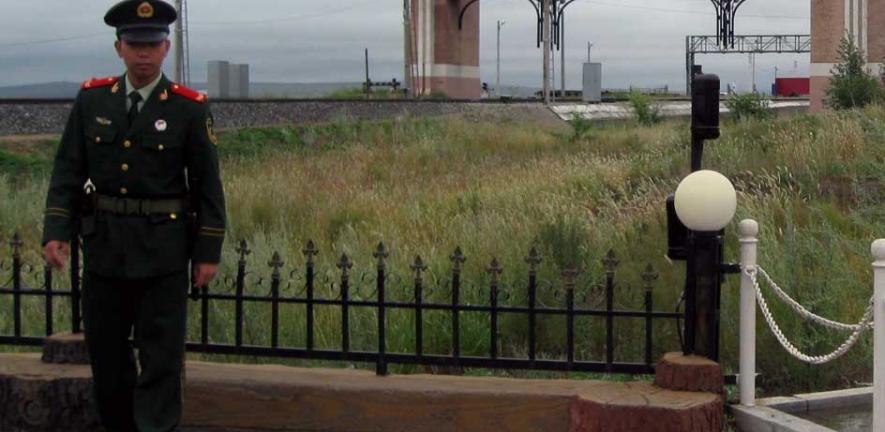
A new project based in Cambridge’s Division of Social Anthropology is looking at interactions between China, Mongolia and Russia at the point where these nations meet – on the immense border that separates them.
A new project based in Cambridge’s Division of Social Anthropology is looking at interactions between China, Mongolia and Russia at the point where these nations meet – on the immense border that separates them.
On one hand, the border is where cultural differences and divergent international strategies become evident; on the other hand, it is where new partnerships are developing.
China and Russia are growing economic and political powers that share thousands of miles of border. Despite this proximity, their practical, local interactions with each other — and with their third neighbour Mongolia — are rarely discussed. There is no better place than the border to compare the remarkably dissimilar ways that economic development, the rule of law, citizen rights, migration and inequality are managed. It is here that many incipient trends are emerging. On one hand, the border is where cultural differences and divergent international strategies become evident; on the other hand, it is where new partnerships are developing.
Last month saw the launch of a new project, “Where Rising Powers meet: China and Russia at their north Asian border”, within the Mongolia & Inner Asia Studies Unit, in Cambridge's Division of Social Anthropology. The project will run for three years under the leadership of Professor Caroline Humphrey, a renowned expert on the region. Professor Humphrey will head a multidisciplinary team of 16 researchers who will carry out research at various sites along the border, from Mongolia in the west to Vladivostok in the east. The researchers are all specialists in their field, with years of experience of research along this strategic border. Several of them are native to the region.
The new research programme builds on an earlier project that ran from January 2010 to January 2011. It brought together anthropologists, sociologists, economists and stakeholders with specialist knowledge of the region into productive dialogue. Their work was presented at two workshops where multiple political, economic and sociocultural dimensions of the border were explored. The workshops led to the publication of Frontier Encounters: Knowledge and Practice at the Russian, Chinese and Mongolian Border (Open Book Publishers, Cambridge, 2012), the first book in English to focus on the border between China and Russia.
The researchers contributing to the new project are drawn from a diverse range of backgrounds and national institutions. Among them is Dr Natalia Ryzhova, an economic sociologist at the Far Eastern Branch of the Russian Academy of Science. Her research has shown that while Russian media have consistently associated criminal networks at the border with the Chinese, in reality many of these networks have emerged through partnerships between Russians and Chinese, who both exploit legal loopholes and navigate a complex bribery system.
The past two decades have also seen the renewal of ancient ties between the indigenous populations on either side of the border. For most of the Soviet period, and particularly during the final three decades when the border was sealed shut and heavily militarised, there was very little contact between them. Yet the region is home to many ethnic groups, such as the Mongols and Buryats whose traditional nomadic lifestyle did not recognise national boundaries. When the border reopened in the early 1990s, divided communities were able to renew their kinship ties. Many of these groups, such as Mongols, Evenki or Koreans, have been able to exploit their connections and take on the role of middlemen.
Another member of the research team is Dr Sayana Namsaraeva, herself a Buryat. She will examine the practices of ethnic traders and the personal and professional ties they weave with their co-ethnics beyond the border. She will also map out the cross-border routes taken by people and their commodities. This kind of research is crucial to an understanding of the enduring significance of the cultural and ethnic links that have historically underpinned the region and continue to do so. Dr Namsaraeva’s research will also highlight the many ways in which communities on either side have developed along divergent axes, and the different worldviews they have come to adopt as citizens of Russia, China or Mongolia.
The chasm between different worldviews is especially visible in border cities such as Blagoveshchensk in Russia and Heihe in China, which stand opposite each other on the banks of Amur River, separated by just 500 metres yet reflecting strikingly different cultures. These two cities have been a focus of research by Dr Franck Billé, co-ordinator of the project in Cambridge’s Division of Social Anthropology. His work looks at the ideological dimension of Sino-Russian interaction and t he tectonic shifts that accompany China’s rise as a world power. Whereas local Russians previously assumed a certain cultural superiority and saw their city as a beacon of progress and modernity in Asia, unparalleled numbers of Russians are now studying Chinese with the ambition to work in China.
These recent developments appear to reflect wider geopolitical and economic trends. While the Russian Far East has witnessed strong outmigration in the last two decades, China’s economic footprint has increased. As a result, Moscow has grown increasingly wary of Chinese involvement and is seeking to reassert its presence in the Far East. But regional centres do not always share the views expressed in capital cities. In many ways Vladivostok (meaning ‘Ruler of the East’ in Russian) symbolises this growing tension between central and regional powers. It is a city where important world and regional summits are being held, but it is also a city with a history of resistance against Moscow’s rule. Professor Humphrey’s work in Vladivostok will examine the crucial role of this strategic city in the context of a complex geopolitical background.
Frontier Encounters: Knowledge and Practice at the Russian, Chinese and Mongolian Border presents a wide range of views on how the borders between these countries are enacted, produced, and crossed. It also sheds light on global uncertainties: China’s search for energy resources and the employment of its huge population, Russia’s fear of Chinese migration, and the precarious economic independence of Mongolia as its neighbours negotiate to extract its plentiful resources.
The volume is available in hardback, paperback and e-book. It can also be read for free on the publisher’s website, at http://www.openbookpublishers.com
More information about the project is available on the website www.northasianborders.net
This work is licensed under a Creative Commons Licence. If you use this content on your site please link back to this page.





